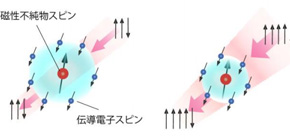
Successful detection and control of the Kondo effect by using spin current
Will lead to the clarification of condensed matter physics opened by spintronics
Electrical resistivity in dilute magnetic alloys turns upward at around the Kondo temperature as the temperature decreases, which is known as the Kondo effect. This phenomenon was theoretically explained by Dr. KONDO Jun in 1964; however, his theory and actual experimental results conflicted at low temperatures.
As theoretical research progressed, it became known that spin-flip scattering was suppressed and electrical resistance dropped to a certain degree because the Kondo singlet, or the ground state in which the spin of magnetic impurities and the spin of conduction electrons are antiferromagnetically bound, is formed in the very low temperature range. The Kondo effect in dilute magnetic alloys was detected and analyzed by applying electric current and correctly measuring electrical resistivity; however, details of the correlation between a pure spin current, or a flow of spin without charge current, and the Kondo effect was not known.
A research group led by Professor HAMAYA Kohei at the Graduate School of Engineering Science and Associate Professor TANIYAMA Tomoyasu at the Institute of Innovative Research (IIR), Tokyo Institute of Technology, succeeded in detecting the Kondo effect in dilute magnetic alloys via the conduction of spin current in micro spin devices using high-performance spintronic materials, a world first.
This group succeeded in directly observing spin current conduction in the Kondo alloy by using ferromagnetic Heusler alloys, high-performance spintronic materials, as the source of generating spin currents, clarifying that the spin of magnetic impurities contributed to spin-flip scattering at far higher temperatures over the Kondo temperature. Furthermore, using spin current conduction, this group directly clarified that an influence by spin-flip scattering didn’t change at temperatures beyond the Kondo temperature. This group also discovered that the influence by spin-flip scattering was tuned by artificially increasing spin injection. This means that the Kondo effect can be controlled by spin currents.
In this study, interactions between spin of the magnetic impurities and the spin of conduction electrons were directly observed as results of spin current conduction, and it was revealed that the level of Kondo effect could be controlled by changing the quantity of spin current injection into Kondo alloys. This group’s achievement is the proposal of a new method of detection and control by using spin current to the Kondo effect, which has been studied in the last 50 years, and will contribute to the clarification of condensed matter physics by using spin current.
Abstract
We study the effect of a pure spin current on the Kondo singlet in a diluted magnetic alloy using nonlocal lateral spin valve structures with highly spin polarized Co 2 FeSi electrodes. Temperature dependence of the nonlocal spin signals shows a sharp reduction with decreasing temperature, followed by a plateau corresponding to the low temperature Fermi liquid regime below the Kondo temperature ( T K ). The spin diffusion length of the Kondo alloy is found to increase with increasing spin accumulation. The results are in agreement with the intuitive description that the Kondo singlet cannot survive any more in sufficiently large spin accumulation even below T K .

Figure 1

Figure 2
To learn more about this research, please view the full research report entitled “ Direct evidence for suppression of the Kondo effect due to pure spin current ” at this page of the Physical Review B website.
Related link
- Hamaya Laboratory, Graduate School of Engineering Science, Osaka Universit y (link in Japanese)
